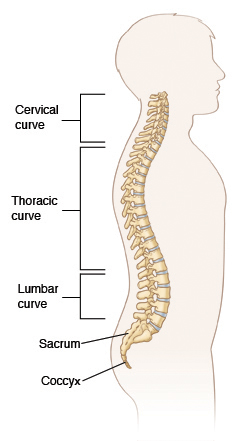Back Spasm (No Trauma)

Spasm of the back muscles can occur after a sudden forceful twisting or bending such as in a car accident. A spasm can also happen after a simple awkward movement. Or after lifting something heavy without the correct body positioning. In any case, muscle spasm adds to the pain. Sleeping in an awkward position or on a poor quality mattress can also cause this. Some people respond to emotional stress by tensing the muscles of their back.
Lasting pain may need further assessment. Or you may need other types of treatment such as physical therapy.
You don't always need X-rays for the first assessment of back pain, unless you had a physical injury such as from a car accident or fall. If your pain continues and doesn't respond to medical treatment, X-rays and other tests may then be done.
Home care
-
As soon as possible, start sitting or walking again. This will help prevent problems from a long bed rest. These problems include muscle weakness, worsening back stiffness and pain, and blood clots in the legs.
-
When in bed, try to find a position of comfort. A firm mattress is best. Try lying flat on your back with pillows under your knees. You can also try lying on your side with your knees bent up toward your chest and a pillow between your knees.
-
Don't sit for long periods. Also limit car rides and travel. This puts more stress on the lower back than standing or walking.
-
During the first 24 to 72 hours after an injury or flare-up, put an ice pack on the painful area for 20 minutes, then remove it for 20 minutes. Do this over a period of 60 to 90 minutes, or several times a day. This will reduce swelling and pain. Always wrap ice packs in a thin towel.
-
You can start with ice, then switch to heat. Heat from a hot shower, hot bath, or heating pad reduces pain and works well for muscle spasms. Put heat on the painful area for 20 minutes, then remove it for 20 minutes. Do this over a period of 60 to 90 minutes, or several times a day. Don't sleep on a heating pad. It can burn or damage skin.
-
Alternate using ice and heat.
-
Be aware of safe lifting methods. don't lift anything over 15 pounds until all the pain is gone.
Gentle stretching will help your back heal faster. Do this simple routine 2 to 3 times a day until your back is feeling better.
-
Lie on your back with your knees bent and both feet on the ground.
-
Slowly raise your left knee to your chest as you flatten your lower back against the floor. Hold for 20 to 30 seconds.
-
Relax and repeat the exercise with your right knee.
-
Do 2 to 3 of these exercises for each leg.
-
Repeat, hugging both knees to your chest at the same time.
-
Don't bounce, but use a gentle pull.
Medicines
Talk with your doctor before using medicine, especially if you have other medical problems or are taking other medicines.
You may use over-the-counter medicines such as acetaminophen, ibuprofen, or naproxen to control pain, unless your healthcare provider prescribed another pain medicine. Talk with your provider if you have a chronic condition such as diabetes, liver or kidney disease, stomach ulcer, or digestive bleeding. Also talk with them if you're taking blood thinners.
Be careful if you are given prescription pain medicine, opioids, or medicine for muscle spasm. They can cause drowsiness. It can affect your coordination, reflexes, and judgment. Don't drive or operate heavy machinery when taking these medicines. Take pain medicine only as prescribed by your provider.
Follow-up care
Follow up with your doctor as advised. You may need physical therapy or more tests.
If X-rays were taken, they may be reviewed by a radiologist. You'll be told of any new findings that may affect your care.
Call 911
Call 911 if any of these occur:
-
Trouble breathing
-
Confusion
-
Drowsiness or trouble awakening
-
Fainting or loss of consciousness
-
Rapid or very slow heart rate
-
Loss of bowel or bladder control
When to get medical care
Call your healthcare provider right away if any of these occur:
-
Pain gets worse or spreads to your legs
-
Weakness or numbness in 1 or both legs
-
Numbness in the groin or genital area
-
Fever of 100.4ºF (38ºC) or higher, or as advised by your provider
-
Chills
-
Burning feeling or pain when you pee